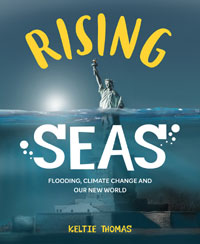| ________________
CM . . .
. Volume XXIV Number 27. . . .March 16, 2018

 |
Rising Seas: Flooding, Climate Change and Our New World.
Keltie Thomas. Art by Belle Wuthrich & Kath Boake W.
Richmond Hill, ON: Firefly Books, 2018.
64 pp., pbk. & hc., $9.95 (pbk.), $19.95 (hc.).
ISBN 978-0-2281-0021-8 (pbk.), ISBN 978-0-2281-0022-5 (hc.).
Subject Headings:
Sea level-Juvenile literature.
Floods-Juvenile literature.
Climate changes-Juvenile literature.
Grades 4-8 / Ages 9-13.
Review by Gillian Richardson.
***½ /4
|
| |
|

excerpt:
Fast Forward to the Future
Imagine that the Netherlands had absolutely no protection from floods. By 2100, sea level rise would bury a huge chunk of it completely underwater. About half the country is less than 3 feet (1 m) above sea level. Even its present-day sea barriers wouldn’t shut out the rising water completely. But this nation of seabusters is not about to let the sea gain any ground. The Netherlands has the world’s most advanced plan to combat sea level rise. They’re also looking to nature to beat the sea. For example, they’re shoring up sand dunes to hold the sea back with a “Sand Engine”—a half-mile-long (0.8 km) strip of sand. By 2030 or so, they expect wind and sea currents to have spread this sand 6 miles (9.6 km) along the shore, creating a natural barrier. Go seabusters, go!
With climate change frequently front and centre in the media, Rising Seas is well-timed to focus on one disastrous effect—rising sea levels and the resulting destruction. The first half dozen pages form an extended introduction that outlines the problem with small chunks of text, graphics, graphs and maps. This detail sets the foundation for the central portion of the book, a look at 15 major sites that are most vulnerable to the risk of rising seas. Each site is described with statistics (location, population, size, height above sea level), a quick look at the present situation (Here and Now) and how things could change (Fast Forward to the Future). Inserts highlight one special aspect or dramatic event and may discuss scientific studies or technology that can help mitigate future damage. A double spread following the fact pages offers suggested ways readers can contribute to carbon emission reduction. The Glossary is extensive and includes graphical explanations of the Carbon Cycle and Water Cycle. The resource list includes books and websites. A four-page Index completes the book.
The lengthy introductory detail is well worth a careful read. It reveals the role water plays on our planet, how much of the world’s population has chosen to live on coastal sites, how rising temperatures lead to rising oceans, and how nations are currently considering the threat in terms of protection, adaptation and/or relocation, Once readers have digested this well-researched information, they will be better equipped to understand specific (and potential) consequences in store for each of the accounts that follow. The entire population of New Orleans, for example, is facing a double danger from sinking ground and rising sea levels. They’ve already had a taste of the destruction during Hurricane Katrina which flooded 80 percent of its low-lying areas. One solution for them would be to move to higher ground. That isn’t an option, though, for the residents of about 1,000 islands that make up the Marshall Islands in the South Pacific. They face the total loss of their country and the need to relocate. While there is no permanent human presence in Antarctica, melting ice shelves will lead to an increase in global sea levels. The unknown: how fast will this happen? The mix of what we already know and what science suggests will happen gives young readers plenty to consider, discuss and question.
The statistics are a strong feature here. They allow a quick comparison for the reader between different venues: e.g. sea levels at New York (parts only 1.5 m above sea level), Nova Scotia (coast is at sea level), the Netherlands (lowest point 7 m below sea level). Overall, the text is quite small and fairly dense, qualities that might be off-putting for casual readers. But wise color choices help to make it easy enough to read, and the writing style is conversational and appealing. The bright yellow background on some pages is also used to help headings and outline maps stand out. One typo on page 18: you won’t find a reference to the Wall St. Bull on page 17, as stated, but on page 19.
To enhance the seriousness of the threat of rising seas, the illustrators have opened some accounts with striking “photo illustrations” showing the sea water swallowing up iconic structures, such as the high rises along Miami Beach, New York’s Statue of Liberty, and Mumbai’s historic Gateway to India monument. In particular, the cover illustration of Liberty up to her waist in water will attract attention and is a strong motivator for the curious reader to open the book. Photographs and drawings are nicely combined for an overall highly visual presentation. Rising Seas could be the basis for classroom studies of climate change as we face the real threat of rising seas.
Highly Recommended.
Gillian Richardson is a freelance writer living in BC.

© CM Association
CC BY-NC-ND
Hosted by:
University of Manitoba
ISSN 1201-9364
|
This Creative Commons license allows you to download the review and share it with others as long as you credit the CM Association. You cannot change the review in any way or use it commercially.
Commercial use is available through a contract with the CM Association. This Creative Commons license allows publishers whose works are being reviewed to download and share said CM reviews provided you credit the CM Association. |
Next Review | Table of Contents for This Issue - March 16, 2018.
CM Home | Back Issues | Search | CM Archive | Profiles Archive
|
